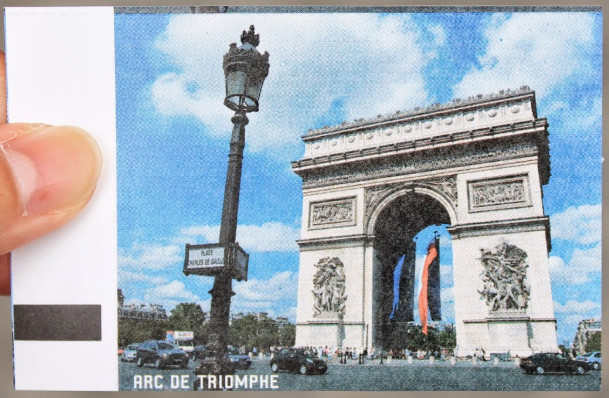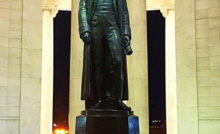Arc de Triomphe – Facts, Tickets, Hours, History


The Arc de Triomphe, also known as The Arc de Triomphe de l’Étoile, is a really famous Parisian monument. It is located in the middle of Place Charles de Gaulle towards the west of the Champs-Élysées. The Arc de Triomphe du Carrousel is a smaller arch different from the Arc de Triomphe and is located towards the west side of the Louvre.
The Arc de Triomphe was commissioned in 1806 by Napoleon to commemorate his Austerlitz victory. It was constructed as a monument to honor those people who fought and died for their country in the Napoleonic and the French Revolutionary Wars. The names of all the generals and the French victories are inscribed on the outer and inner surfaces of the arch. The Tomb of the Unknown Soldier from World War I is located under the monument.
The Arc de Triomphe has been witness to some of the most tragic and important events in French history, including flying of the Nazi swastika during WWII occupation of the city, triumphant marches, and rallying of allied forces by Charles de Gaulle under the arch in 1944 as a liberation symbol. In 1919 after end of WWI, a biplane was flown by Charles Godefroy under the main vault of the arch. Every year, the Tour de France ends at the Arch while the Bastille Day Military Parade starts at the Arch.
Arc de Triomphe – Construction and Design
Jean Chalgrin was the architect of the Arc de Triomphe. The foundations were laid in 1810, 4 years after being commissioned by Napoleon. After several stoppages in construction, due to the death of Jean in 1811 and other factors, the monument was finished in 1836. The Arch had become blackened due to car exhaust and cool soot by the 1960s. It was bleached them in the mid 60s.
The Arc de Triomphe got its inspiration from the Arch of Titus located in Rome, Italy. It is 50 meters/164 feet tall, 45 m/148 ft wide, and 22 m/72 ft deep. The bigger vault is 29.19 m/95.8 ft tall and 14.62 m/48 ft in width. The smaller sloping vaults 8.44 m/27.7 ft wide and 18.68 m/61.3 ft tall. It used to be the tallest triumphal arch in the world until it was surpassed in 1938 by the 67 m/220 feet tall Monumento a la Revolución arch located in Mexico City.
Architect Jean Chalgrin gave an astylar ancient Roman architecture design in its neoclassical version to the Arc de Triomphe. The sculpture works on the arch feature the representations of key academic French sculptors Jean-Pierre Cortot, Antoine Étex, François Rude, Philippe Joseph Henri Lemaire, and James Pradier. The primary sculptures are independent works and not friezes integral to the arch.
The base/four pillars of the monument features 4 sculptural groups as listed below:
- François Rude’s La Marseillaise/Le Départ de 1792 sculptural group depicts the uprising of 10th August and the reason for the French First Republic. A winged Liberty is there above the volunteers. Its allegorically represented France calling forth her people and that was used as the belt buckle for Marshal of France honorary rank.
- Antoine Étex’s La Résistance de 1814 depicts the War of the Sixth Coalition and the resistance of the French against the Allied armies.
- Jean-Pierre Cortot’s Le Triomphe de 1810 depicts the Treaty of Schönbrunn and features the goddess of Victory placing the crown on Napoleon. The goddess has a protective hand on Paris city kneeling at her feet. It is easy to spot Paris city as her crown is the city walls.
- Antoine Étex’s La Paix de 1815 shows the Treaty of Paris
The attic has engraved names of great battles during the Napoleonic and French Revolutionary Wars. The grand arcades are embellished with allegorical shapes representing Roman mythology characters. The inside facades of the grand arches feature engravings of French victories. The inside facades of the smaller arches have engravings of French military leaders. The foot of the Arc de Triomphe features varied plaques, including the Proclamation of Republic plaque and the De Gaulle speech plaque. In Feb 2007, a permanent exhibition of new media and steel created by architect Christophe Girault and artist Maurice Benayoun opened within the monument.
Beneath the Arc de Triomphe is the Tomb of the Unknown Soldier from World War I. It was interred in 1920 on Armistice Day and features an eternal flame. All military parades used to march under the arch before the Unknown Soldier was interred. Since 1920, all parades go around the arches.
Arc de Triomphe – Timings and Tickets
The Arc de Triomphe is open to public on all days other than May 1, Jan 1, Dec 25, and in the mornings on July 14, May 8, and Nov 11. It is open from 10 AM to 11 PM from April 1 to Sep 30 and from 10 AM to 10.30 PM from Oct 1 to March 31. Visitors can enter the monument till 45 minutes before it is closing time.
There is no fee to walk under the arches and around the base. There is a fee of around $12 for entry to the top of the arch via the stairway. Entry is free for teens and children, adults from EU younger than 26 years old, secondary and primary school teachers (barring temporary exhibitions), jobseekers/unemployed, disabled +1, and French welfare recipients. Entry is free on first Sunday of every month from Nov 1 to March 31.
The view from the top of the Arc de Triomphe is spectacular. You will get a bird’s eye-view of the surroundings and be able to see almost all popular landmarks in the city. Walk around on the top and see the twelve grand boulevards merging into the center at the Arc de Triomphe to form an “etoile” or a star shape.
Arc de Triomphe-Photos
Recent Posts
Lampedusa, Italy – Attractions, Weather, Hotels, Restaurants, Things to do
Lampedusa is a small Italian island located in the Mediterranean Sea, south of Sicily and…
Eklutna lake (Alaska) – Campgrounds, Trail, Directions from Anchorage, Best time to Visit
Eklutna Lake is a large, glacier-fed lake located in Chugach State Park in Southcentral Alaska,…
Most Dangerous Cities in Florida
While Florida is a popular destination for tourists and retirees, like any other state, it…
Sperlonga, Italy – Attractions, Hotels, Restaurants, Beaches, Sculptures (Travel Guide)
Sperlonga is a beautiful coastal town located on the Tyrrhenian Sea in the province of…
Devil’s Pool – Victoria Falls – Timings, Tour Operators, Best time to Visit, Safety Tips
The Devil's Pool is a natural infinity pool located at the top of Victoria Falls…
Volterra, Italy – Attractions, Things to do, Hotels, Restaurants (Travel Guide)
Volterra is a historic town located in the Tuscany region of Italy, known for its…

